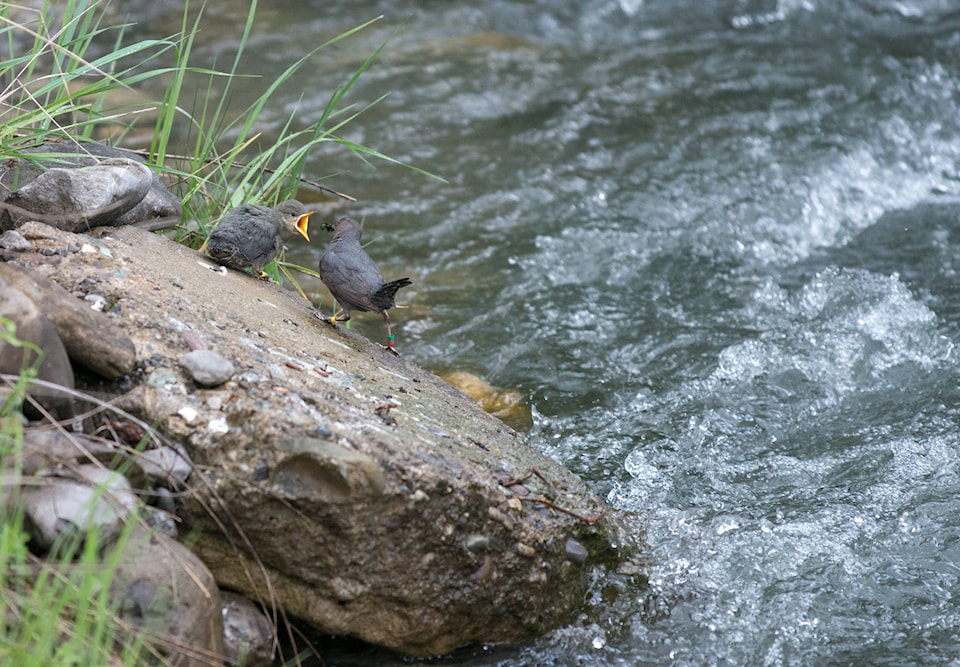Two biologists are currently studying North America’s only aquatic songbird, the American Dipper, and took a class from The Fernie Academy out for a field-lesson in ecotoxicology.
The American Dipper was found nesting under a bridge in Fernie a few months ago, among many other locations on rivers and creeks throughout the Elk Valley. It is being studied and used as a bio-indicator for stream conditions because of its close relationship with the water and resident status. For these reasons, the bird would be greatly affected if the quality of water were to change.
Helmi Hess, a masters student from UBC working through Environment and Climate Change Canada is the principal field worker for this project. Martin Pilon is Hess’s field tech, and is new to the project this season.
Hess is currently studying if, and how the bird has been affected by rising selenium levels, comparing data to results of an earlier study conducted in the Elk Valley in the early 2000s.
On Friday, Hess and Pilon took the class to the place where an American Dipper resides, close to the Fairy Creek passenger bridge. There, they took the class through an in-depth study about the aquatic songbird, and how the water plays such a vital role in its existence. They also talked about the history of the surrounding waterways.
Earlier in the day, the biologists had observed a baby American Dipper, which they banded and released back to the father. The father fed the fledgling, and guarded it on a rock on the bank of the creek. When the students arrived, the father was captured in a net, and carefully examined, much like a doctor’s checkup. Measurements of the bird were taken, including weight, wing length, and a blood sample. The bird was then retagged and released. The biologists will continue monitoring this species throughout the year to understand the birds’ movements over the seasons and to monitor the success of this year’s hatchlings.
Being an aquatic bird, the American Dipper obtains all of its food from the water. They dive down into the water and fish for insect larvae, who eat periphyton (bacteria, algae) off of the rocks. Compared to the water around it, periphyton contains a much higher concentration of selenium because it collects it from the water. Each step up the food chain, selenium levels rise due to bio-magnification.
The American Dipper sits around the fifth tropic level, and therefore is exposed to an extreme amount of selenium. High selenium concentrations can cause deformities in the eggs of egg-laying vertebrates, including birds, reptiles and amphibians. Selenium incorporates itself into amino acids, which are required for the proper development of eyes, muscles, bills, bones and legs. If the concentrations of selenium are too high, these do not develop properly.
Hess and Pilon have been testing different waterways, in order to analyze and compare the regular levels of selenium in alpine streams versus the selenium levels in the water found leaching out of the surrounding coal mines.
The biologists have been working on streams that connect to the Elk River, spanning north of Elkford and south to Lake Koocanusa. With this information they will be comparing selenium levels in reference streams to several tributaries downstream of the coal mines, to find out the amount of selenium being put into the river from the mining areas.
So far they have started analyzing water upstream of the mines, and have gone down to Lake Koocanusa, studying tributaries along the way. Right now, they are in the process of gaining closer access to mining areas.
The last study conducted on American Dippers in the Elk Valley, which also included the Spotted Sandpiper, was in 2002. At that time, selenium levels in the Elk River near Sparwood were approximately 4ug/L (four micrograms per litre). As of 2016, selenium levels in the same location sat at approximately 10ug/L.
In 2012, the Ministry of Environment updated the guideline level for selenium concentration in the water column at 2ug/L to reduce the risk of negative effects in wildlife and fish. Hess’s samples have found levels around 40ug/L in the water downstream of the mines in fall 2016, and there have been reports of substantially higher levels closer to the mines.
Selenium is a naturally-occurring element, which is released as rock breaks down naturally. When rocks from the mountains are exposed by open-pit mining, selenium release is expedited by the process. This causes selenium levels to rise beyond what is normal for wildlife and humans. The approved maximum level of selenium for human consumption by the B.C. Ministry of Environment’s Water Protection and Sustainability Branch is 10ug/L. Humans do not generally have an issue with selenium over-exposure, because our water is treated to take out high levels of selenium. However, there is increased risk of high selenium exposure in people who consume large amounts of freshwater fish which have been exposed to selenium.
Since the end of March when the biologists began to find the American Dipper nests, they have collected one egg from each nest to be sent off for analysis. They will be comparing these results to those of the biologists in 2002, to see if there has been a rise in selenium concentration in the tissues of the birds and assess any changes in productivity and survivorship. Preliminary results are expected by the end of this year.
Efforts to reduce the amount of selenium leaching from coal mines is already underway; water treatment facilities are being set up in the area. There is one currently in operation, just downstream of the Line Creek mine. There are other treatment plants in the works; the next is set to go online by the end of 2018. If severe negative effects are observed in the birds, Hess’s data will be evaluated to determine any changes that should take place in the valley to mitigate these issues in the future.
